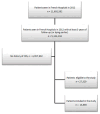Unsupervised Cluster Analysis in Patients with Cardiorenal Syndromes: Identifying Vascular Aspects
- PMID: 38892870
- PMCID: PMC11172943
- DOI: 10.3390/jcm13113159
Unsupervised Cluster Analysis in Patients with Cardiorenal Syndromes: Identifying Vascular Aspects
Abstract
Background/Objectives: Cardiorenal syndrome (CRS) is a disorder of the heart and kidneys, with one type of organ dysfunction affecting the other. The pathophysiology is complex, and its actual description has been questioned. We used clustering analysis to identify clinically relevant phenogroups among patients with CRS. Methods: Data for patients admitted from 1 January 2012 to 31 December 2012 were collected from the French national medico-administrative database. Patients with a diagnosis of heart failure and chronic kidney disease and at least 5 years of follow-up were included. Results: In total, 13,665 patients were included and four clusters were identified. Cluster 1 could be described as the vascular-diabetes cluster. It comprised 1930 patients (14.1%), among which 60% had diabetes, 94% had coronary artery disease (CAD), and 80% had peripheral artery disease (PAD). Cluster 2 could be described as the vascular cluster. It comprised 2487 patients (18.2%), among which 33% had diabetes, 85% had CAD, and 78% had PAD. Cluster 3 could be described as the metabolic cluster. It comprised 2163 patients (15.8%), among which 87% had diabetes, 67% dyslipidemia, and 62% obesity. Cluster 4 comprised 7085 patients (51.8%) and could be described as the low-vascular cluster. The vascular cluster was the only one associated with a higher risk of cardiovascular death (HR: 1.48 [1.32-1.66]). The metabolic cluster was associated with a higher risk of kidney replacement therapy (HR: 1.33 [1.17-1.51]). Conclusions: Our study supports a new classification of CRS based on the vascular aspect of pathophysiology differentiating microvascular or macrovascular lesions. These results could have an impact on patients' medical treatment.
Keywords: cardiorenal syndrome; chronic kidney disease; heart failure.
Conflict of interest statement
The authors declare no conflicts of interest.
Figures




Similar articles
-
Long-term impact of cardiorenal syndromes on major outcomes based on their chronology: a comprehensive French nationwide cohort study.Nephrol Dial Transplant. 2022 Nov 23;37(12):2386-2397. doi: 10.1093/ndt/gfac153. Nephrol Dial Transplant. 2022. PMID: 35438794
-
Type 2 diabetes and cardiorenal syndromes. A nationwide French hospital cohort study.Diabetes Metab. 2023 May;49(3):101441. doi: 10.1016/j.diabet.2023.101441. Epub 2023 Mar 15. Diabetes Metab. 2023. PMID: 36931430
-
Cardiorenal syndrome in critical care: the acute cardiorenal and renocardiac syndromes.Adv Chronic Kidney Dis. 2013 Jan;20(1):56-66. doi: 10.1053/j.ackd.2012.10.005. Adv Chronic Kidney Dis. 2013. PMID: 23265597 Review.
-
Cardiorenal Syndrome.Crit Care Clin. 2021 Apr;37(2):335-347. doi: 10.1016/j.ccc.2020.11.003. Epub 2021 Feb 13. Crit Care Clin. 2021. PMID: 33752859 Review.
-
[Cardiorenal syndrome, current understanding].Recenti Prog Med. 2009 Apr;100(4):202-13. Recenti Prog Med. 2009. PMID: 19554920 Review. Italian.
Cited by
-
Nomogram establishment for gastrointestinal bleeding prediction in ICU patients with traumatic brain injury based on the MIMIC-IV database.Front Med (Lausanne). 2025 Apr 14;12:1523535. doi: 10.3389/fmed.2025.1523535. eCollection 2025. Front Med (Lausanne). 2025. PMID: 40297154 Free PMC article.
References
-
- Ronco C., McCullough P., Anker S.D., Anand I., Aspromonte N., Bagshaw S.M., Bellomo R., Berl T., Bobek I., Cruz D.N., et al. Cardio-Renal Syndromes: Report from the Consensus Conference of the Acute Dialysis Quality Initiative. Eur. Heart J. 2010;31:703–711. doi: 10.1093/eurheartj/ehp507. - DOI - PMC - PubMed
-
- Rangaswami J., Bhalla V., de Boer I.H., Staruschenko A., Sharp J.A., Singh R.R., Lo K.B., Tuttle K., Vaduganathan M., Ventura H., et al. Cardiorenal Protection with the Newer Antidiabetic Agents in Patients with Diabetes and Chronic Kidney Disease: A Scientific Statement from the American Heart Association. Circulation. 2020;142:e265–e286. doi: 10.1161/CIR.0000000000000920. - DOI - PubMed
-
- Halimi J.-M., de Fréminville J.-B., Gatault P., Bisson A., Gueguen J., Goin N., Sautenet B., Maisons V., Herbert J., Angoulvant D., et al. Long-Term Impact of Cardiorenal Syndromes on Major Outcomes Based on Their Chronology: A Comprehensive French Nationwide Cohort Study. Nephrol. Dial. Transplant. 2022;37:2386–2397. doi: 10.1093/ndt/gfac153. - DOI - PubMed
LinkOut - more resources
Full Text Sources
Miscellaneous

